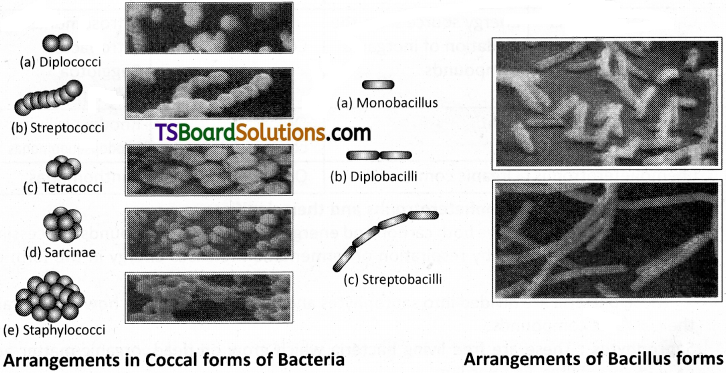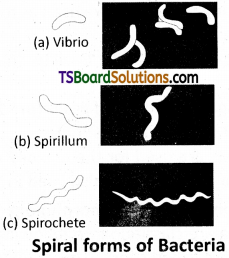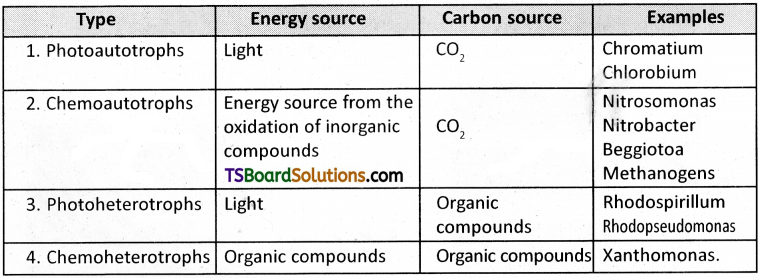Telangana TSBIE TS Inter 2nd Year Botany Study Material 7th Lesson Bacteria Textbook Questions and Answers.
TS Inter 2nd Year Botany Study Material 7th Lesson Bacteria
Very Short Answer Type Questions
Question 1.
Write briefly on the occurrence of micro-organisms.
Answer:
- Microorganisms are ubiquitous. They are found in soil, water, air, and inside living beings.
- They occur in a variety of foods and can withstand extreme cold, heat, and drought conditions.
Question 2.
Define Microbiology.
Answer:
- Microbiology is a branch of biological science that deals with the study of microorganisms like protozoa, microscopic algae, fungi (yeasts and molds) bacteria and viruses.
- It is concerned with structure, function, classification, ways to control and using the activities of microorganisms.
Question 3.
Name the bacteria which is a common inhabitant of human intestine. How is it used in biotechnology? [May 2014]
Answer:
- Escherichia coli (E.coli) is a common inhabitant of human intestine.
- It is used in Recombinant DNA technology for the production of insulin harmone.
Question 4.
What are pleomorphic bacteria? Give an example. [May ’17, Mar. ’14]
Answer:
- The bacteria that keep on changing their shape depending upon the type of environment and nutrients available are called pleomorphic bacteria.
- Eg : Acetobacter.
Question 5.
What is sex pilus? What is its function?
Answer:
- The process of conjugation requires a special conjugation apparatus called the conjugation tube or pilus or sex pilus.
- Its function is to transfer F plasmid from F+ donor to F– recipient.
![]()
Question 6.
What is a genophore? [Mar. 2019]
Answer:
- Bacterial chromosome is also called as genophore.
- It is the main genetic material of bacteria.
Question 7.
What is a plasmid? What is its significance?
Answer:
- Plasmids : Small circular, double stranded DNA molecules present is addition to the bacterial chromosome (genophore) in Bacteria.
- Plasmids contain genes, for resistance to drugs, production of toxins and enzymes. These are used as tools (vectors) in modern genetic engineering technique.
Question 8.
What is conjugation? Who discovered it and in which organism? [Mar. 2017]
Answer:
- Conjugation is a process, in which two live bacteria come together and the donor cell directly transfers DNA to the recipient cell.
- This process was first observed by Lederberg and Tatum (1946) in Escherichia coli.
Question 9.
What is transformation? Who discovered it and in which organism? [Mar. 2020]
Answer:
- Transformation is uptake of naked DNA fragments from the surrounding environment and the expression of that genetic information in the recipient cell.
- Frederick Griffith (1928) discovered it in Streptococcus pneumoniae.
Question 10.
What is transduction? Who discovered it and in which organism? [March 2010]
Answer:
- The transfer of genetic material from one bacterium to anotherthrough bacteriophage is known as transduction,
- It was discovered by Lederberg and Zinder (1951) in Salmonella typhimurium.
Short Answer Type Questions
Question 1.
Explain the importance of Microbiology.
Answer:
Microbiology is a branch of biological science that deals with the study of micro-organisms. Micro-organisms are useful in several ways for the welfare of human society.
1. Soil fertility :
Micro-organisms decompose dead plants and animals thereby enrich the soil with nutrients which are utilized by plants. Microbes also play vital role in recycling of elements like C, N, O, S, and P.
2. Antibiotics :
Alexander Fleming isolated an antibiotic Penicillin from a fungus, Penicillium notatum. Waksman isolated an antibiotic Streptomycin from a bacterium, Streptomyces griseus.
3. Industrial products :
Industrial products like enzymes, amino acids, vitamins, organic acids and alcohols are commercially produced using microbes.
4. Dairy products :
Lactobacillus, commonly known as Lactic Acid Bacteria (LAB) grows in milk and convert it to curd, which also improves its natural quality by increasing vitamin B12, food stuff, like cheese, yogurt are the byproducts of microbial growth.
5. Mining :
Metals like Uranium can be extracted with 50% reduced cost by using microbes.
6. Tools in Genetic Engineering :
Microbes are used as tools in altering the genetic make up of organisms.
7. Biocontrol agents :
Micro-organisms like Bacillus thuringiensis are used to control plant diseases and pests.,
8. Production of Biogas :
Biogas, a mixture of gases (predominantly methane) produced by the microbial activity. It may be used as fuel.
9. Exomicrobiology :
Microbes are used for the exploration of life in the outer space.
10. Sewage disposal :
Bacteria and fungi are also used in sewage disposal.
![]()
Question 2.
How are bacteria classified on the basis of morphology?
Answer:
Based on their shape bacteria are classified into following types.
1. Cocci :
Spherical bacteria are called cocci. They are 6 types.
a) Monococcus : A single spherical bacterium.
b) Diplococcus : A pair of spherical bacterium.
c) Tetracocci : A group of four spherical bacteria.
d) Streptococcus : A linear chain of spherical bacteria arranged in a single row.
e) Sarcinae : Cocci arranged in cubes of eight.
f) Staphylococci : A group of cocci bacteria forming irregular shapes producing bunches.
2. Bacillus :
Elongated rod shaped bacteria are called bacillus. They are 3 types.
a) Monobacillus : A single elongated rod shaped bacterium.
b) Diplobacillus : Paired cells of bacilli.
c) Streptobacillus : Chains of bacilli appearing like straws.

3. Spiral forms :
Vibrioid : Cells having less than one complete twist.
Spirillum : Cells that have more than one complete twist – a distinct helical shape. Spirochete : Cells are slender, long and cork-screw shaped.
4. Pleomorphic :
These bacteria change their shape depending upon the type of environment and nutrients available. This phenomenon is called pleomorphism.
Eg : Acetobacter.

Question 3.
How are bacteria classified on the basis of number and distribution of flagella?
Answer:
Based on the number and distribution of flagella bacteria are classified into 4 types.
- Monotrichous : A single flagellum is present on one side of the cell.
- Lophotrichous : A tuft of flagella are present on one side of the cell.
- Amphitrichous : Tufts of flagella or a single flagellum on either end of the cell.
- Peritrichous : Many flagella are distributed all over the cell surface.
Question 4.
What are the nutritional groups of bacteria based on their source of energy and carbon?
Answer:
Four major nutritional groups of bacteria based on the source of energy and carbon are described below.

Question 5.
Write briefly about chemoheterotrophs and their significance.
Answer:
Chemoheterotrophs derive both carbon and energy from organic compounds. Processing these organic molecules by respiration or fermentation releases energy in the form of ATP.
These bacteria are divided into saprophytes and parasites basing on how they obtain their organic compounds.
Saprophytes :
These are free living bacteria which grow on dead, organic matter are called Saprophytes. Eg : Bacillus
Parasites :
The bacteria which grow on or in living host and cause diseases are called parasites.
Eg : Xanthomonas, Salmonella.
Significance :
Most microbes of biomedical importance belong to these two categories. Bdellovibrio bacteriovorous grows as a parasite on some harmful bacteria and their abundance is supposed to be responsible for the microbial purity of Ganges waters.
![]()
Question 6.
Explain the conjugation in bacteria.
Answer:
Conjugation :
- The transfer of genetic material (DNA) through direct cell to cell contact is known as conjugation.
- It was first reported by Lederberg and Tatum in 1946 in Escherichia coli.
- In E.coli, in addition to the bacterial chromosome or genophore which is the main genetic material, bacteria contain small circular, double stranded DNA molecules called plasmids or ‘F’ factor.
- E.coli having F factor are called F+ cells or donor cells and the cells without F factor are called F– cells or acceptor cells.
- F+ cells have pilus or sex pilus. During conjugation the F+ and F– strains come close together. Once contact is established, the pilus shortens to bring the two bacteria close together.
- A conjugation.tube is established. The plasmid in F+ replicates and forms a copy of it, which moves to the acceptor cell (F). Thus donor bacterium generally retain a copy of genetic material that is being transferred.
Long Answer Type Questions
Question 1.
Explain different methods of sexual reproduction in Bacteria.
Answer:
Sexual reproduction :
True sexual reproduction is absent in bacteria. However the exchange of genetic material is reported through other methods.
Three types of genetic recombinations are reported in different species of bacteria. They are
- Conjugation
- Transformation and
- Transduction.
1. Conjugation :
- The transfer of genetic material (DNA) through direct cell to cell contact is known as conjugation.
- It was first reported by Lederberg and Tatum in 1946 in Escherichia coli.
- In E.coli, in addition to the bacterial chromosome or genophore which is the main genetic material, bacteria contain small circular, double stranded DNA molecules called plasmids or ‘F’ factor.
- E.coli having F factor are called F+ cells or donor cells and the cells without F factor are called F– cells or acceptor cells.
- F+ cells have pilus or sex pilus. During conjugation the F+ and F strains come close together. Once contact is established, the pilus shortens to bring the two bacteria close together.
- A conjugation tube is established, The plasmid in F+ replicates and forms a copy of it, which moves to the acceptor cell (F). Thus donor bacterium generally retain a copy of genetic material that is being transferred.
2. Transformation :
Transformation is uptake of naked DNA fragments from the surrounding environment and the expression of that genetic information in the
recipient cell. That is, the recipient cell has now acquired a characteristic that is previously lacked. This mode of bacterial genetic recombination was discovered by Frederick Griffith in streptococcus pneumoniae.
![]()
3. Transduction :
The transfer of genetic material from one bacterium to another through bacteriophage is known as transduction.
Question 2.
“Bacteria are friends and foes of man” – discuss.
Answer:
Bacteria are known to be the casual agents of plant, animal and human diseases. At the same time there are many bacteria which are directly or indirectly beneficial to man. Thus, these organisms can be considered both as ‘friends and foes of man’.
Beneficial activities:
- Microbes are now used in extracting valuable metals like uranium from rocks. The process is known as Bio-mining. The use of microbes in mining reduces the cost of production by more than 50%.
- DNA components from bacteria are used as Biosensors that can detect biologically active toxic pollutants.
- Microbes also find application in medical diagnostics, food and fermentation operations.
- The most important development in Biotechnology depends on the possibility of altering the genetic makeup of bacteria through genetic engineering.
- Microbes in household products :
a) A common example is the production of curd from milk micro-organisms such as Lactobacillus and others, commonly called lactic acid bacteria (LAB), grow in milk and convert into curd. It also improves its nutritional quality by increasing vitamin B12.
b) Some of our food stuffs like cheese, yogurt are also actually the by- products of microbial growth. - Microbes are used as biocontrol agents. Biocontrol refers to the use of biological methods for controlling plant diseases and pests.
- Many industrial products like enzymes, amino acids, vitamins, organic acid and alcohols are commercially produced by micro organisms.
- Microorganism decompose dead plants and animals and enrich the soil nutrients which can be used by plants. They play an important role in recycling of elements.
- Microbes cause diseases in plants and human beings. On the other hand, they help in creating disease free world by producing antibiotics and vaccinations. Penicillin was the antibiotic discovered by Alexander Fleming from a fungus, penicillin notatum. The antibiotic obtained from bacteria streptomyces griseus is known as streptomycin.
- Biogas is a mixture of gases (containing predominantly methane) produced by the microbial activity and which may be used as fuel.
Harmful activities:
Some bacteria that cause human diseases are
| Bacterium | Diseases |
| Clostridium tetani | Tetanus |
| Clostridium botulinum | Botulism |
| Vibrio cholera | Cholera |
| Salmonella typhi | Typhoid |
| Corynebacterium diphtheriae | Diphtheria |
| Mycobacterium tuberculosis | Tuberculosis |
| Diplococcus pneumonia | Pneumonia |
| Mycobacterium leprae | Leprosy |
| Neisseria gonorrhoea | Gonorrhoea |
| Treponema pallidum | Syphilis |
Bacteria causes plant diseases :
| Disease | Bacterium |
| Blight of rice | Xanthomonas oryzae |
| Citrus canker | X. axonopodis pv. citri |
| Crown gall of apples and pears | Agrobacterium tumefaciens |
Bacteria also cause animal diseases :
| Disease | Bacterium |
| Anthrax of sheep | Bacillus anthracis |
| Tuberculosis of dogs, cattle etc. | Mycobacterium tuberculosis |
| Actinomycosis of cattle | Mycobacterium boris |
| Vibriosis | Vibrio tetus |
Intext Question Answers
Question 1.
Many people believe that bacteria do little more than cause human illness and infectious diseases. How does the information in this chapter help you correct that misconception?
Answer:
Most of the bacteria are beneficial activities than harmful activities.
Bacteria are known to be the casual agents of plant, animal and human diseases. At the same time there are many bacteria which are directly or indirectly beneficial to humans. Thus, these organisms can be considered both as ‘friends and foes of man’.”
Beneficial activities:
- Microbes are now used in extracting valuable metals like uranium from rocks. The process is known as Bio-mining. The use of microbes in mining reduces the cost of production by more than 50%.
- DNA components from bacteria are used as Biosensors that can detect biologically active toxic pollutants.
- Microbes also find application in medical diagnostics, food and fermentation operations.
- The most important development in Biotechnology depends on the possibility of altering the genetic makeup of bacteria through genetic engineering.
- Microbes in household products :
a) A common example is the production of curd from milk micro-organisms such as Lactobacillus and others, commonly called lactic acid bacteria (LAB), grow in milk and convert into curd. It also improves its nutritional quality by increasing vitamin Bir
b) Some of our food stuffs like cheese, yogurt are also actually the by-products of microbial growth. - Microbes are used as biocontrol agents. Biocontrol refers to the use of biological methods for controlling plant diseases and pests.
- Many industrial products like enzymes, amino acids, vitamins, organic acid and alcohols are commercially produced by microorganisms.
- Microorganism decompose dead plants and animals and enrich the soil nutrients which can be used by plants. They play an important role in recycling of elements.
- Microbes cause diseases in plants and human being. On the other hand, they help in creating disease free world by producing antibiotics and vaccinations. Penicillin was antibiotic obtained from bacteria streptomyces griseus is known as streptomycin.
- Biogas is a mixture of gases (containing predominantly methane) produced by the microbial activity and which may be used as fuel.
Harmful activities:
Some bacteria that cause human diseases are
| Bacterium | Diseases |
| Clostridium tetani | Tetanus |
| Clostridium botulinum | Botulism |
| Vibrio cholera | Cholera |
| Salmonella typhi | Typhoid |
| Corynebacterium diphtheriae | Diphtheria |
| Mycobacterium tuberculosis | Tuberculosis |
| Diplococcus pneumonia | Pneumonia |
| Mycobacterium leprae | Leprosy |
| Neisseria gonorrhoea | Gonorrhoea |
| Treponema pallidum | Syphilis |
Bacteria causes plant diseases ;
| Disease | Bacterium |
| Blight of rice | Xanthomonas oryzae |
| Citrus canker | X. axonopodis pv. citri |
| Crown gall of apples and pears | Agrobacterium tumefaciens |
Bacteria also cause animal diseases :
| Disease | Bacterium |
| Anthrax of sheep | Bacillus anthracis |
| Tuberculosis of dogs, cattle etc. | Mycobacterium tuberculosis |
| Actinomycosis of cattle | Mycobacterium boris |
| Vibriosis | Vibrio tetus |
![]()
Question 2.
Humans produce about 50 grams of feces per day. Scientists estimated in broad terms about one -third of human feces is composed of bacteria. If one E.coli cell weighs 1 × 10-12 g, how many bacteria are there in a day’s feces? How can this be possible?
Answer:
Feces per day = 50 gram
Bacteria present = \(\frac{1}{3}\) × 50 gm
Each bacteria weight = 1 × 10-12 gm
Bacteria in a day’s feces = \(\frac{1}{3}\) × 50 × 1 × 10-12 gm
i.e., 16.66 × 10-12(approx)
Question 3.
An organism is described as a peritrichous bacillus. How might you translate this bacteriological language into a description of the organism?
Answer:
Bacillus indicates that bacteria are rod elongated in shape. Peritrichous indicates that bacteria is having many flagella distributed all over the cell surface flagella are locomotory in function.